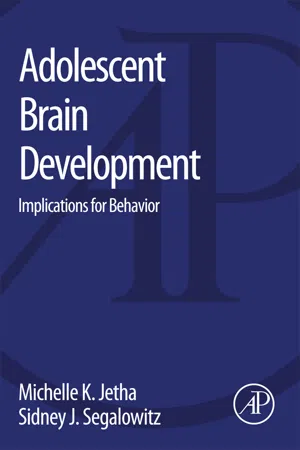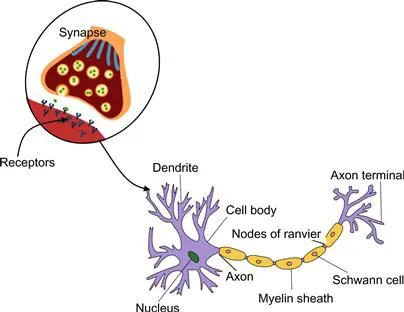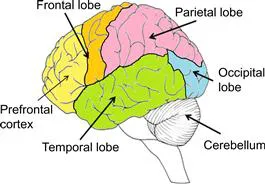
eBook - ePub
Adolescent Brain Development
Implications for Behavior
This is a test
- 100 pages
- English
- ePUB (mobile friendly)
- Available on iOS & Android
eBook - ePub
Book details
Book preview
Table of contents
Citations
About This Book
This comprehensive yet brief overview of the adolescent human brain discusses how the brain develops during this critical period of life and how that development impacts decision-making and risk-taking behavior in the adolescent.
- This originated as a white paper requested by the Canadian government for a specific group looking to understand adolescent brain development in the context of adolescent behaviour
- The paper was not made available to the Canadian government outside of the specific task force that requested it nor to the general public
Frequently asked questions
At the moment all of our mobile-responsive ePub books are available to download via the app. Most of our PDFs are also available to download and we're working on making the final remaining ones downloadable now. Learn more here.
Both plans give you full access to the library and all of Perlego’s features. The only differences are the price and subscription period: With the annual plan you’ll save around 30% compared to 12 months on the monthly plan.
We are an online textbook subscription service, where you can get access to an entire online library for less than the price of a single book per month. With over 1 million books across 1000+ topics, we’ve got you covered! Learn more here.
Look out for the read-aloud symbol on your next book to see if you can listen to it. The read-aloud tool reads text aloud for you, highlighting the text as it is being read. You can pause it, speed it up and slow it down. Learn more here.
Yes, you can access Adolescent Brain Development by Michelle K. Jetha,Sidney Segalowitz in PDF and/or ePUB format, as well as other popular books in Psychology & Developmental Psychology. We have over one million books available in our catalogue for you to explore.
Information
Chapter 1
Structural Brain Development in Late Childhood, Adolescence, and Early Adulthood
1.1 Introduction
The brain, like all bodily structures, goes through a very high rate of growth prenatally and in the early years after birth. However, research has demonstrated that this development spans well into young adulthood and is more protracted than was realized even just a couple of decades ago. The physical changes in gray matter, white matter, and neurotransmitters from late childhood to early adulthood are dramatic and have implications for understanding changes in behavior during this period. They are both progressive (building up) and regressive (reducing and fine tuning) and are sensitive to maturational and environmental influences (see Box 1.1). In this chapter, we provide a general overview of these changes.
Box 1.1 Progressive and Regressive Changes in the Brain
Progressive changes include proliferation of neurons (neurogenesis) and synapses (synaptogenesis), and growth of myelin (myelination).
Regressive changes include cell death and synaptic pruning, both presumably related to usage (the “Use it or lose it” principle).
The triggers for synaptic function are neurotransmitters (such as dopamine, serotonin, norepinephrine, and GABA), which follow their own growth and decline cycles.
1.1.1 The Early Years…
It is well known that the early years are marked by critical periods of brain development. There are billions of neurons in the brain that send messages to one another across synapses (see Figure 1.1) and allow the various regions of the brain to function in a coordinated way. Early in life there is a dramatic period of synaptogenesis that results in an overproduction of synapses, which is followed by a “competition” among neurons and synapses (see Box 1.2). Animal studies have demonstrated that the strengthening or elimination of neurons is dependent on environmental demands and experience; those that are more often used are strengthened, whereas those that are rarely used are eliminated. The process of “weeding out” weaker synapses is known as synaptic pruning and is thought to result in a brain that is more efficient and matches neural connectivity to need.216 Thus, early brain development (birth to 6 years) is an extraordinary time of brain plasticity, where environmental enrichment and deprivation play a major role in shaping and molding the brain for the years to come.
Box 1.2 Early Neural Development
Neural development begins two weeks after conception with the formation of the neural tube (which will become the brain and spinal cord), neuronal proliferation (the few initial cells will continually divide to produce billions of neurons), neural migration (cells migrate to their final destination) and neural differentiation (cells differentiate to become specialized for particular functions).
During the process of neuronal proliferation (mostly completed between the 4th and 7th months of gestation), many more neurons are created than will ultimately be used and maintained.
As neurons complete their migration, they extend axons and dendrites to create synaptic connections. This process is referred to as synaptogenesis and accounts for the connections between neuronal cells (see Figure 1.1).
In early childhood, there is a dramatic period of synaptogenesis that results in an overproduction of synapses, which is followed by a competition among neurons and synapses for neural growth factors, which support cell function. Neurons that receive support will be maintained, while those that do not will die through the process called apoptosis.

Fig. 1.1 Schematic of the neuron and synapse. The synapse is the junction that permits one neuron’s axon to pass a signal to the receiving neuron’s dendrite.
1.1.2 After the Age of Seven…
Although brain volume is about 90% of its adult size by 6 years of age and reaches its adult size by about the age of 12,201 brain development is far from complete. With the advent of new technologies, such as magnetic resonance imaging (MRI), we now know that the brain continues to develop and change throughout the lifespan, although at a slower pace than during the early years. There is a notable surge of synapse growth just before the onset of puberty111 and another prominent period of synaptic pruning and plasticity during the adolescent period. In some brain regions, up to half of the synaptic connections are eliminated.216,282 This second period of substantial synaptic pruning (the first being during the early years) is thought to contribute to the refinement of brain connectivity that is necessary for the emergence of adult brain circuitry (see Chapter 2). Indeed, it has become well accepted in recent years that adolescence encompasses an important period of brain development that is sensitive to the environment in terms of learning and experience, and as such has become the focus of an increasing amount of research.
1.2 Anatomical Changes
Brain maturation over this period, which includes the remodeling and fine-tuning of neural circuitry, does not occur in a linear and uniform pattern. It is specific with respect to brain region, timing, and gender. Before considering these important changes, let us first turn our attention to a brief overview of brain anatomy.
The organization of the brain is, in some respects, analogous to the components of a computer. The surface gray matter is where the brain “processing” takes place, whereas the white matter provides the connectivity or “wiring” between regions. The brain as a whole is divided into two halves, the left and right cerebral hemispheres. Each cerebral hemisphere consists of surface gray matter (the cortex), inner white matter, and a number of gray matter subcortical regions (see Figure 1.9).
Surface gray matter can be further divided into four lobes (see Figure 1.2). The frontal lobe is comprised of the motor cortex, which is central to voluntary movement, and the prefrontal region, which is central to higher-order thinking and executive functions such as strategizing and planning. The parietal lobe primarily serves the functions of touch sensation and spatial thinking. The temporal lobe is involved in language reception, auditory perception, memory, and a number of social cognitive functions. The occipital lobe is central to vision.

Fig. 1.2 Schematic of the lateral surface of the brain. The surface gray matter of the lobes comprises the cortex, consisting of the four lobes, with the prefrontal subdivision of the frontal lobe colored in light yellow. The cerebellum is considered to be one of many subcortical structures (i.e., gray matter below the cortex).
Higher-order functions are mediated by subdivisions of the prefrontal cortex (see Figure 1.3) which work together to subserve complex attention, monitoring of the environment and of the self, and emotional and behavioral control. As we will discuss, several of these prefrontal subdivisions, especially those in the medial prefrontal regions, have been implicated in social and emotional developments.

Fig. 1.3 Schematic of the medial (inside) view of the brain. This view shows the divisions of the medial prefrontal cortex and the anterior cingulate.
The white matter of the brain is made up of the axons that emanate from the cell bodies to send signals to other cells. These axons are insulated by myelin, a sheath that surrounds the axons and promotes signal transmission (see Figure 1.1...
Table of contents
- Cover image
- Title page
- Table of Contents
- Copyright
- Preface
- Introduction
- Chapter 1. Structural Brain Development in Late Childhood, Adolescence, and Early Adulthood
- Chapter 2. Connectivity
- Chapter 3. Social and Emotional Development
- Chapter 4. How Genes and Environment Work Together to Influence Brain Growth and Behavior
- Summary and Implications
- References